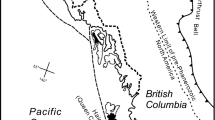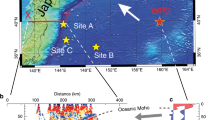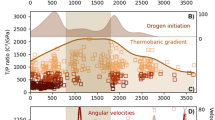Abstract
THE origin of granitic batholiths has been reviewed in the light of our understanding of the processes operative at destructive plate margins1. The thermal patterns at island arcs suggest that significant amounts of thermal energy must be released within downgoing oceanic plates, and that this energy may be transferred to the surface behind island arcs. In these regions heat flow values are abnormally high and andesitic volcanism is present. The high heat flow may be produced because the normal geothermal gradient is enhanced by penetrative convection of magmatic material which is derived from the downgoing plate. Many large granitic batholiths, such as those in Chile, are localised at plate margins, and some authors have proposed that the Sierra Nevada batholith originated in a similar setting along the continental margin in the down-warped portion of the lower crust. Dickenson2 suggested that the magma for the batholiths was produced by partial melting within the downgoing plate, and was subsequently emplaced into the overlying continental crust. Bateman and Dodge3, and Brown1 suggested that emplacement into the lower crust, of andesitic material derived from the mantle, causes partial melting of crustal material, with the mixed product forming the magma for the granitic batholiths.
This is a preview of subscription content, access via your institution
Access options
Subscribe to this journal
Receive 51 print issues and online access
$199.00 per year
only $3.90 per issue
Buy this article
- Purchase on Springer Link
- Instant access to full article PDF
Prices may be subject to local taxes which are calculated during checkout
Similar content being viewed by others
References
Brown, G. C., Nature phys. Sci., 241, 26,(1973).
Dickenson, W. R., Rev. Geophys. Space Phys., 8, 813 (1970).
Bateman, P. C., and Dodge, F. C. W., Bull. geol. Soc. Am., 81, 1665 (1970).
Brown, G. C., and Fyfe, W. S., Contr. Miner. Petrol., 28, 310 (1970).
Robertson, J. K., and Wyllie, P. J., J. Geol., 79, 549 (1971).
Fyfe, W. S., Tectonophysics, 17, 273 (1973).
Reynolds, R. T., Fricker, P. E., and Summers, A. L., J. geophys. Res., 71, 573 (1966).
Bartlett, R. W., Am. J. Sci., 267, 1067 (1969).
Author information
Authors and Affiliations
Rights and permissions
About this article
Cite this article
HODGE, D. Thermal model for origin of granitic batholiths. Nature 251, 297–299 (1974). https://doi.org/10.1038/251297a0
Received:
Issue Date:
DOI: https://doi.org/10.1038/251297a0
This article is cited by
-
What causes subsidence following the 2011 eruption at Nabro (Eritrea)?
Progress in Earth and Planetary Science (2018)
-
Chemical differentiation, cold storage and remobilization of magma in the Earth’s crust
Nature (2018)
-
On granitoid emplacement and related structures. A review
Geologische Rundschau (1987)
-
Thermal convection in magmas generated by hot-plate heating
Nature (1982)
-
Finite-element method in modeling geologic transport processes
Journal of the International Association for Mathematical Geology (1976)
Comments
By submitting a comment you agree to abide by our Terms and Community Guidelines. If you find something abusive or that does not comply with our terms or guidelines please flag it as inappropriate.



